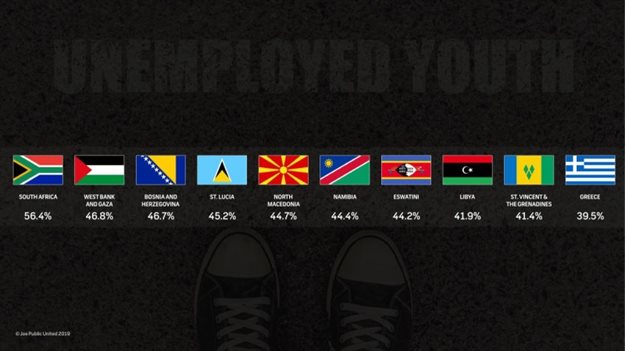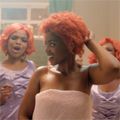Mike dos Santos, co-author and strategic director at Joe Public Shift, and Kalliebree Keynerd, head of social at Joe Public, jointly presented at the recent Social Media Landscape Briefing on Generation Z, aka Generation Fluid, and elaborated on why marketers need to start focussing more on this demographic of the market.
Dos Santos started off by stating that South Africa has an extremely youthful population. He said that this is a trend they see across developing countries, as close to half the country's total population is aged 0-24 years – which means that there are more South Africans under 25 than people living in the whole of Australia.
Millennials
He mentioned that millennials, the generation born between 1980 and 1994, are fast approaching their 40s.
The youngest millennials are turning 25 this year and the definitions of youth internationally go up to 24, therefore, we need to stop referring to millennials as the youth market. Strictly speaking, millennials as from 2019 can no longer be categorised as the youth – both demographically and psychographically.
So who are the successors?
Generation Z
Who is Generation Z? They are:
- Born between 1995 and 2009
- Aged 10 to 24 years
- Just over 15 million in SA
- Over half of the total youth segment
- Over a quarter of SA's total population
- Larger than the entire population of Gauteng
- Globally, size as populations of China and USA
They are considered the most disruptive generation in history. He stated that this is a high-tech and visually-driven audience. They are substantially different from their predecessors, the millennials, and key differences between the two groups include:
- Where millennials are tech-savvy ("digital immigrants"), Generation Z are tech-innate ("digital natives")
- Millennials are a sharing generation, Generation Z is a creating generation
- Millennials are strongly focused on the present/'now', while Generation Z is strongly focused on the future/'tomorrow'
- For millennials self-expression comes first, then team-oriented, where Generation Z is a collective-conscious; but still individualistic ('Generation us')
- Millennials prefer to communicate primarily through text, while Generation Z prefer communicating primarily through images (e.g. emojis, memes)
- Millennials use two screens on average, where Generation Z uses up to 5 screens (multitasking generation)
- Millennials are much more idealistic (raised during the global economic boom) and Generation Z is much more pragmatic (raised during the global economic recession)
- Millennials prefer photoshopped 'reality' – glossy, stylised, idealistic view, where Generation Z is all about #NoFilter and real-life – natural, 'grungy'
- Millennials are strongly influenced by brand authenticity whereas Generation Z expect brand authenticity (and are more critical of inauthenticity)
- For our industry, millennials are all about the consumers in a brand's world, but the power dynamic has shifted so much that the new reality is that the brand is in the consumer's world – Generation Z viewpoint.
According to Dos Santos, Generation Z's world and how they engage with it are best captured in one keyword: fluidity. He calls them 'Generation Fluid'. Fluid in terms of: perception, experience and usage of spaces because the line between physical and digital is becoming increasingly blurred. Or perception, experience and usage of time – so multitasking. Also, definition and expression of self like gender fluidity, career fluency and ways of connecting and relating to the world.
The big themes for our industry to keep in mind about Generation Fluid are:
1. Blurring the lines
A physi-digital world – not only 'always-on' but the distinction between offline and online world is increasingly blurred. Despite the influence of digitisation, Generation Z's desire for authentic, real-life connection is undeniable.
We see many brands, internationally, leveraging this like digital brand Google opening up physical hardware stores where we can engage with Google products and the Google brand in a physical space. Quite a shift for a brand that is traditionally a digital player.

Joe Public United.
2. Multiple actions: a way of life
Generation Z is frequently described as being the multitasking generation, fluidly spreading time and attention across multiple activities and multiple devices or multiple screens or multiple pieces of content.
But how do we break through the clutter? What are the things we need to keep in mind and the techniques and tactics we can use to really breakthrough?
One way is by transmedia storytelling. Using a variety of touch-points to tell a bigger story that appeals to the multimedia, multi-screen fluidity of today's youth.
3. Innovative cross-functional relationships
This speaks to three megatrends characterising the world of Generation Fluid: collaboration, co-creation and convergence.
A new take on the Sharing Economy – which includes unexpected brand relationships, fluid collaborations + supercharged innovation and for a more flexible, interactive and collective-minded market.
4. High unemployment rate + more fluid career choices
The youth unemployment rate (i.e. 15 to 24) in SA is currently at 56.4%. This is the highest in the world!
In response, the youth in SA is becoming increasingly industrious – leading to entrepreneurship and initiatives like SA Teen Entrepreneur.

© Joe Public United.
Joe Public's head of social Kalliebree Keynerd took over to show us a few case studies of several campaigns showcasing these themes.
Keynerd introduced us to Lil Miquela. A popular Instagram model and music artist followed by the likes of Game Of Thrones’ Sophie Turner, Diplo and Mark Ronson. However, she's not real, she and her friends are virtual people and were created by virtual influencer created by Los Angeles-based company Brud.
It poses the question: Could virtual influencers be the future of commerce, social, fashion? Balmain has also invested in creating the first 100 super virtual models. Juniper Research estimated that the global fashion industry will invest $3.6bn in artificial intelligence technology, this year.
Dos Santos mentioned that it's interesting because on the one hand they (Generation Z/Fluid) are looking for those one-on-one, individual, authentic, real-life experiences, yet virtual influencers are a thing. He said there is this constant contradiction between the virtual and the real, the tangible and the intangible.
Linking to the point of paradoxes, Keynerd introduced us to a brand named Carlings that created a digital clothing collection to address the idea that people want to be fashionable but they don't necessarily want to deal with the waste that fashion creates. Gen Zs are attracted to ideas like these. Watch the case study below:
Next, Keynerd showed us an example of a campaign by Taco Bell – which created a pop-up hotel and that illustrates Gen Z's need for experiential activations. Take a look:
She quoted Deborah Brand, the VP of Development and Design at Taco Bell, who said: "It's all about storytelling. We're trying to build a person.
The brands that survive are the ones that customers relate to as a friend, the ones they invite home again and again.
Thereafter, Keynerd spoke a little more about transmedia storytelling explaining that this type of storytelling creates a seamless content experience to keep users engaged in a singular narrative across a variety of content formats.
She showed us a Joe Public campaign she says demonstrates this: Chicken Licken's #NeedaSoulSister campaign. Click on the link below to read all about it:
The results were:
- Highest/best results of any Chicken Licken campaign over the last two years
- 23.7% Engagement rate
- 40.8% view rate
- Gif views = 13 million views
- Total reach of #NeedaSoulSister: eight million
She also spoke about cross-functional collabs and explained that it helps to break down silos and form unexpected partnerships. To demonstrate, she used another example of a campaign that Joe Public did for Converse. Redefining the brand’s conversation, the concept includes women who add their voice and share their stories completely unscripted – bringing the relevant and much-needed dialogue to the forefront.
Another example of cross-functional collaborations, Keynerd showed us an international collaboration between Dunkin' Donuts and Dove. The brands paired up and hosted an activation on 1 October 2018 to celebrate women who always run on coffee and dry shampoo. Dunkin' Donuts also collaborated with Saucony and released a limited edition running shoe ahead of the Boston Marathon.

Joe Public United.
So what does the future look like? To answer this question, Keynerd showed us a case study that showcases a pop culture phenomenon that she says she feels really embodies Generation Fluid:
Lil Nas X's story began after he dropped out of college and decided to become an influencer – trying to make money off the content he posted on social media, particularly Twitter. He wanted to create a "memeable" song with lots of catchphrases. While looking for beats, he stumbled across one produced by a Dutch record producer, YoungKio, created using an old Nine Inch Nails track, with a trap sound, very much like an industrial tech sound.

© Joe Public United.
Lil Nas X created a song, mashing the two genres of music (country music being the other genre) and then uploaded the track called "Old Town Road", to YouTube using footage from Red Dead Redemption 2, a video game. He also uploaded it to Soundcloud. Keynerd said it was a mashing of platforms, spaces and genres and then it started trending and it went viral on TikTok when people started doing the #OldTownRoadChallenge.
The song went viral and country music radio stations started playing it. It moved up the country charts and then Billboard decided to remove it from the country charts because they felt the song wasn't country enough. This started to open up questions around genre and race and exclusion. Lil Nas X commented on this: "The song is country trap. It's not one, it's not the other. It's both. It should be on both." The whole story played out online and then Billy Ray Cyrus jumped on the bandwagon with a tweet:
This spawned him being on the song. And then eventually they filmed the version we know now and a short film. Furthermore, during Pride Month, Lil Nas X also came out as gay during this period. 
© Joe Public United.
If we go back to him wanting to make a memeable song with catchphrases – he actually managed to do that because one of the lines in the song is "Wrangler on my booty." Wrangler used this opportunity to create a whole Old Town Road range and if you scanned the Wrangler label, it would previously unreleased footage from the five-minute movie that they produced.

© Joe Public United.
Some of the stats from the Lil Nas X case study:
- 19 weeks on the Hot 100 Billboard Charts
- YouTube's No. one song of the summer in the US and in South Africa
- One billion times streamed through on-demand audio- and video-streaming platforms (i.e. Spotify and Youtube); one million plays on Spotify alone
- 143 million streams (across platforms) in one week
- 38,000+ number of times the teaser video was retweeted
- A compilation video of TikToks inspired by the song has been viewed more than eight million times
She concluded the presentation with a look at the future from a social media perspective and left us with these insights:
- Nothing is certain. Diversify. Keep in touch with what's going on. Read. Look outside of your own space
- Take risks. Try new platforms, methods and techniques
- Discover who you are as a brand and tell a story of your life. Figure out what that means and carry it through from beginning to end
- If you don't get it, that's okay. Other people will
Social Media Landscape Briefings is an event that was organised by Marketing Mix Conferences. For more information, visit the website by clicking here. For more on Britefire and what they do, click here and you can connect with Joe Public United via their website and for the latest updates and news, click through to their press office.









































